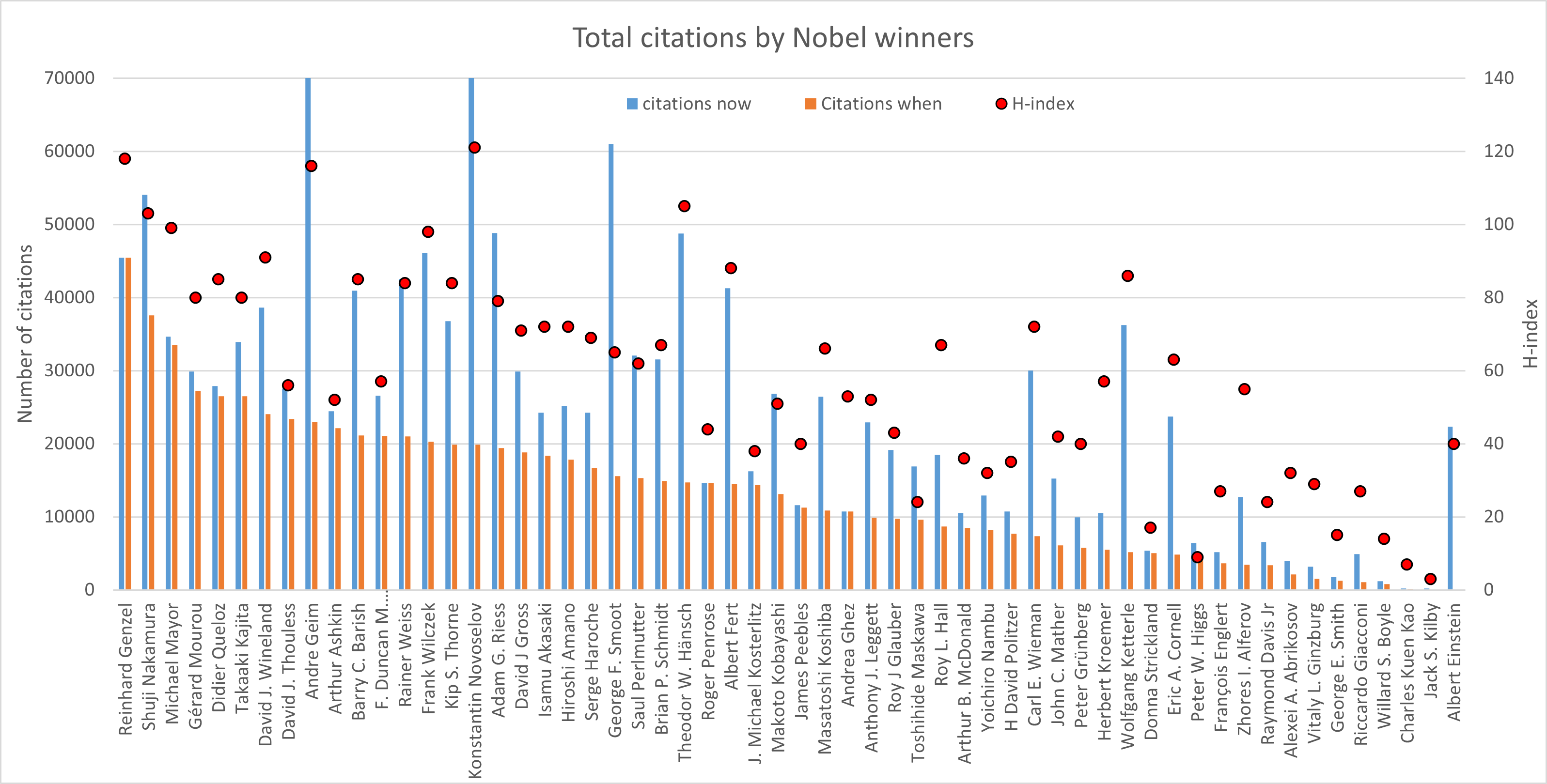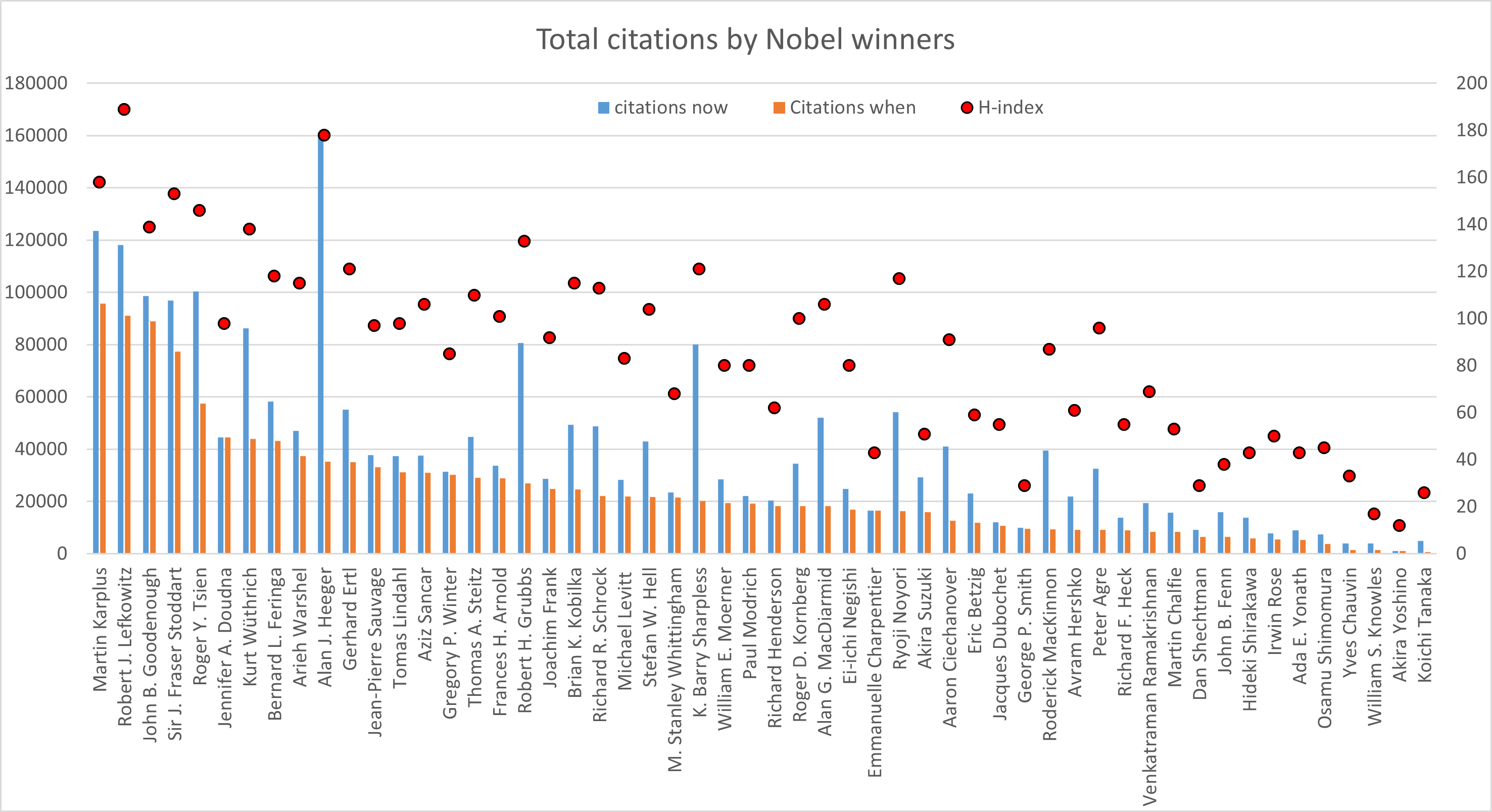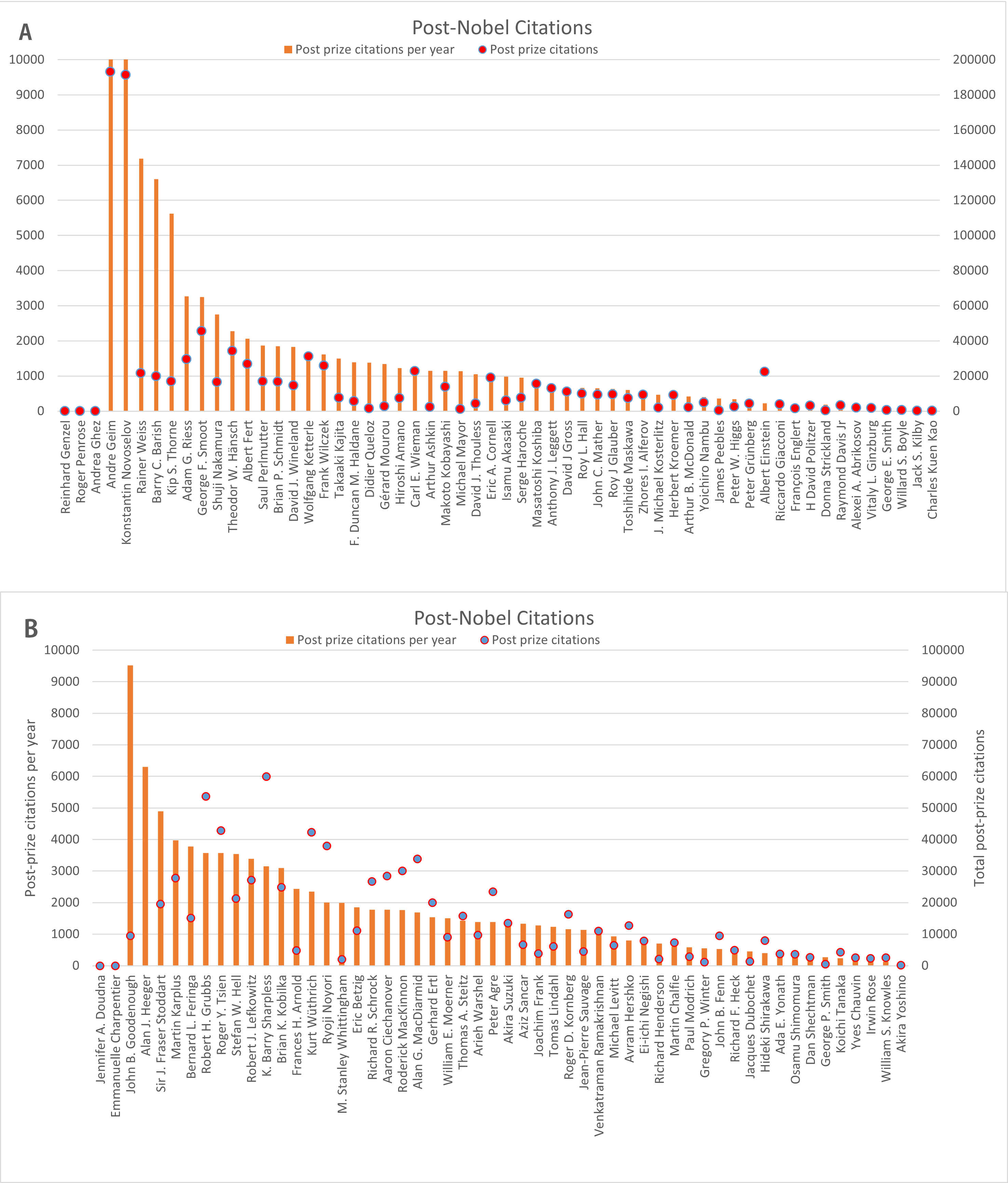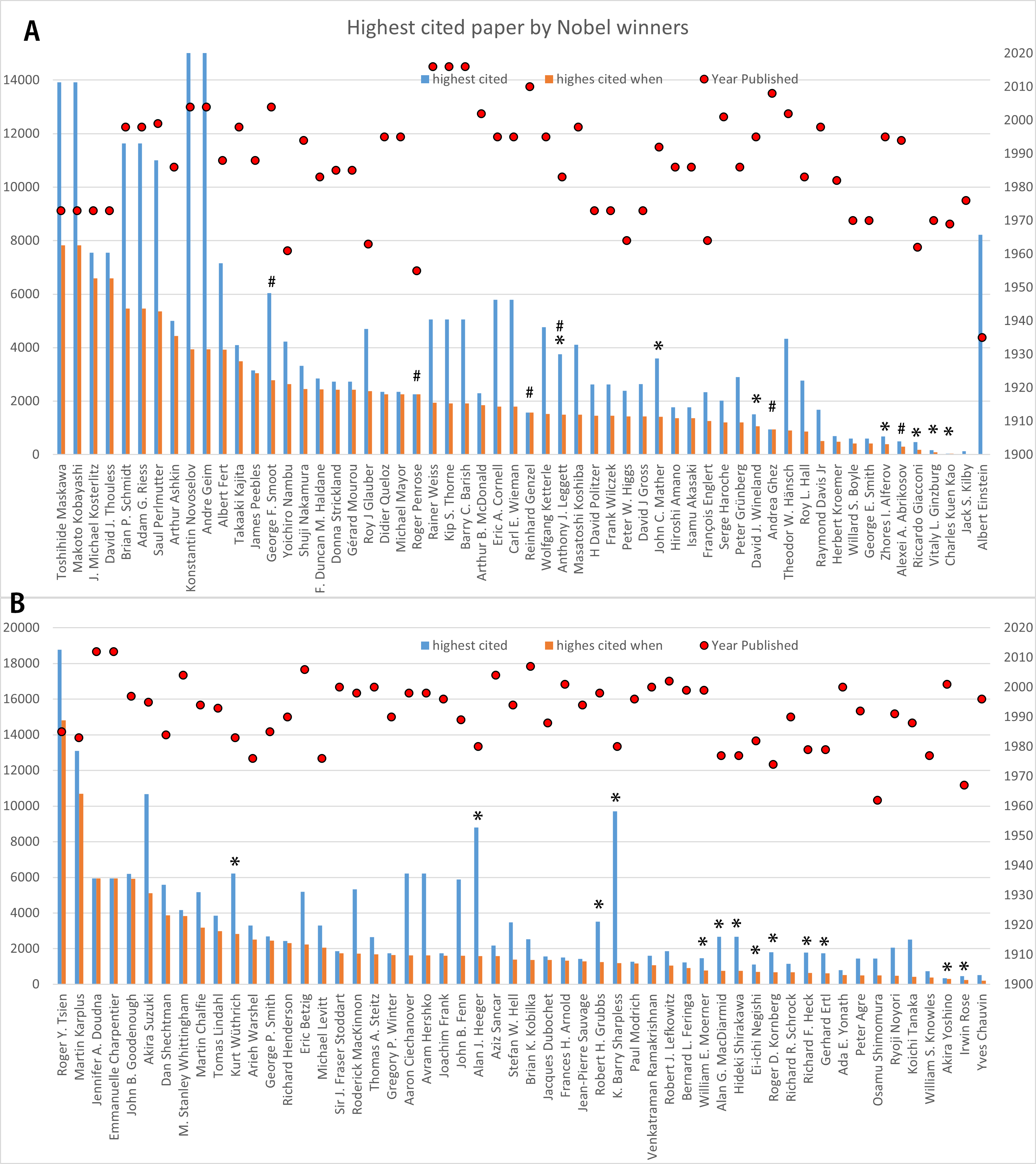How many citations does it take to win a Nobel Prize? It’s a stupid question, I know, because Nobel prizes in the sciences, unlike the literature prize, are not given as a lifetime achievement award. Theoretically, it’s enough to have one really bright idea, and then not do much else. But most Nobel prize winners are already well-known in their fields, and it’s rarely a huge surprise who gets the award for a certain topic.1
So just for the fun of it I went to Scopus2 to check on the number of citations of this year’s winners of the physics prize… and then the previous year’s… and then…3 When I made it back to the year 2000, I thought I had spent enough time and had a fairly decent dataset of 57 Nobelists.
It’s immediately evident that the Nobel prize winners are not just your average Joe4 who had a brainwave, but very well cited scientists. The average number of citations, when they got the prize, is 138145, which place them firmly in the top 1% of researchers.6 But the variation is huge! The standard deviation is almost 10000. We have this year’s winner Reinhard Genzel, who was cited 45000 times on one end, and Jack Kilby – electrical engineer at TI, who didn’t really do academic publications, but nonetheless started the modern age with the invention of the integrated circuit – on the other with 32 citations.

The same set of data for the chemistry winners can be seen in Fig 2 below. It looks quite similar, except that chemists are cited much more than physicists (mean = 24304, std = 22077, median = 18760,5).

Clearly, some Nobel winners were superstars already when they got the prize – Karplus, Lefkowitz, Goodenough7, Genzel, Nakamura. Then some became superstars after the Nobel. Geim and Novoselov stand out, but there are others like Heeger, Sharpless, Grubbs, Smoot, Ketterle… Then there are the ones who were tapped by the Nobel committee late in life and didn’t do much work after the award. We can see this in figure 3, which show the number of citations per year after the award. Jennifer Doudna, of course, has zero post-Nobel citations, but she is already one of the highest cited Nobel winners and got over 6000 new citations in 2020 on a massively increasing trajectory. I think we can calmly count her to the superstar group.

Superstars aside, I find the bottom of the list even more fascinating. They are mostly people working in companies rather than in academia, who invented an instrument or component. These inventions might be of outstanding importance, but rather don’t get cited… if it was even published outside of a patent. Willard Boyle and George Smith invented the CCD, which for ever changed first astronomy and then photography. But most people don’t cite their camera for a good photo! If they were cited the same way as those authors who create new methods8, almost every paper in astronomy over the last decades should give a nod to Boyle and Smith.
But as said, the Nobels are not lifetime achievement awards. So, what about the papers where the awarded discovery/invention was described? Fig 4 shows the highest cited article by each of the Nobel laureates. Mostly this is the paper that describes the discovery awarded9, but not always. Also, in quite a few cases, the most cited paper at the time of the award is not the same as the most cited paper now. Barry Sharpless’s most cited work (by far) concerns click-chemistry10 and George Smooth is a co-author of the biyearly Review of Particle Physics. Roger Penrose, although awarded for black hole-theory, is mostly known for his mathematical works. Or possibly for his tiles… but then it sounds like he’s a bathroom decorator.

Through all these data, one award really stands out – graphene! At the time I thought it was a bit early, the material had been discovered only 6 years before, and I was afraid the hype would fizzle out, like for fullerenes. But since the Nobel11 the field has veritably exploded! From a modest start the interest has grown exponentially (literally), and now more than 20,000 papers a year is published in the field. Geim and Novoselov have also proven beyond doubt that they didn’t just stumble over a discovery that they left to others to exploit. They have been leading lights in graphene research over the last decade. In 2004, when the graphene paper was published, Novoselov was a young researcher who got 30-ish citations per year. Now, >20,000!12
So, to answer the question above: how many citations do you need to get a Nobel. The answer seems to be none at all if you’re an instrument maker. But most Nobelists are very highly cited indeed.
- That, of course, doesn’t mean that the topic is not a surprise…
- The data for Masakawa and Kobayashi actually come from Google Scholar, since they have mainly published in journals not indexed in Scopus. For the Russians, Alferov, Ginzburg, and Abrikosov the numbers are probably too low. Higher citation values can be found in M. Cardona, W. Marx, Vitaly L. Ginzburg—A Bibliometric Study, J. Supercond. Nov. Magn. 19 (2007) 459–466. doi:10.1007/s10948-006-0173-8.
- Yes, I was trying to avoid other things I should’ve been doing!
- In fact, there are no Joes. But three Davids, two Arthurs, Georges, Peters, and Roys. And two women.
- The median is very close to the average – 13100.
- J.P.A. Ioannidis, K.W. Boyack, J. Baas, Updated science-wide author databases of standardized citation indicators, PLOS Biol. 18 (2020) e3000918. doi:10.1371/journal.pbio.3000918.
- Note to self – please avoid obvious puns!
- When Nature listed the top 100 most cited papers of all times, all of the top 10 were different methods, lead by Lowry with a whopping 300,000+ citations!
- Or one of a group of papers in the topic. I could maybe somehow have counted citations to a group of papers. But that’s an awful lot of work, so… Nope!
- Although, if one should believe the murmur, it might very well become a Nobel paper!
- Though not, I think, because of it.
- That kind of means that each graphene paper on average cites one Novoselov paper.